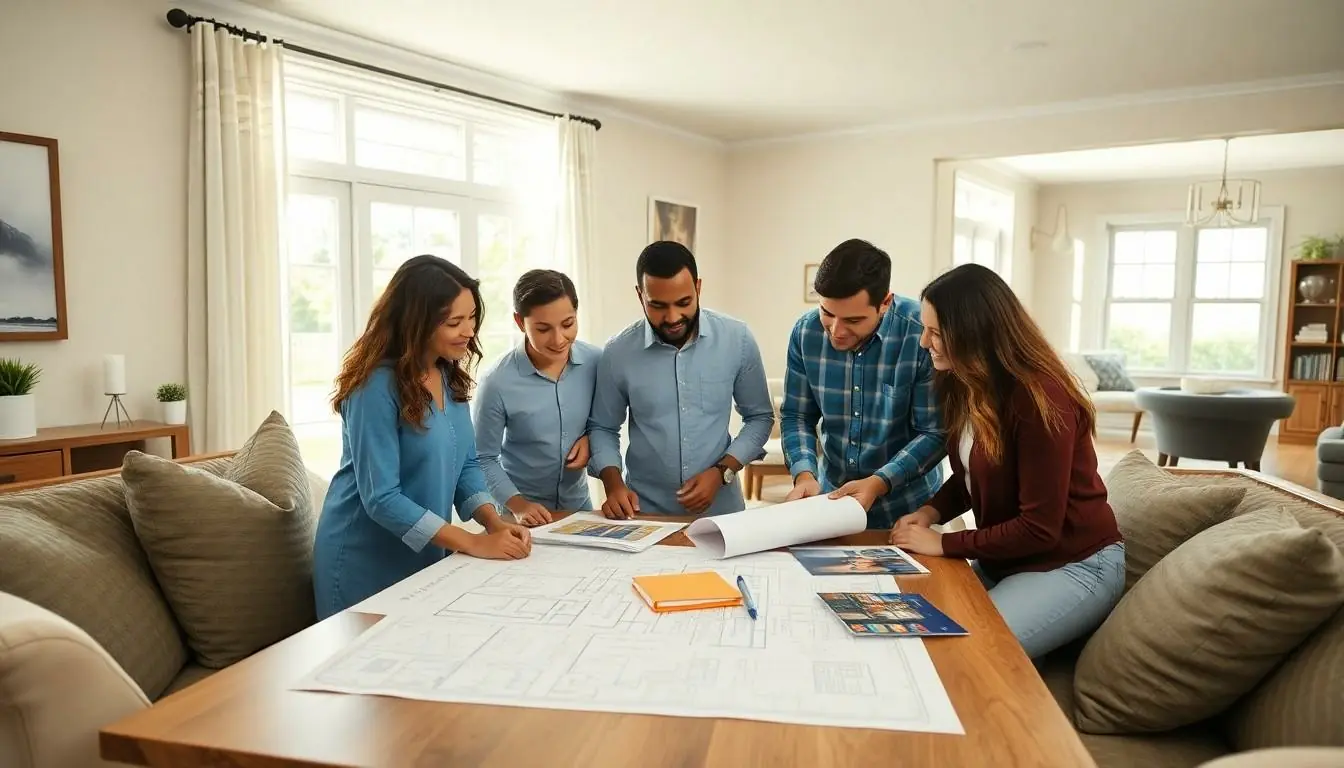Building a custom home is like crafting a masterpiece, but instead of paint and canvas, it’s all about bricks and dreams. Imagine waking up in a space that’s uniquely yours, where every corner reflects your personality. It’s not just a house; it’s a sanctuary tailored to your whims and wishes.
But let’s be real—navigating the world of custom home building can feel like trying to solve a Rubik’s cube blindfolded. From choosing the right materials to finding the perfect layout, the process can be overwhelming. Don’t worry though! With the right guidance, you can turn that daunting task into an exciting adventure. Buckle up as we dive into the essentials of creating your dream abode, ensuring it’s as fun as it is functional.
Table of Contents
ToggleUnderstanding Custom Homes
Custom homes represent a unique approach to residential construction. These homes cater to individual preferences and needs, differing significantly from standard home designs. Homeowners can select every aspect, from layouts and materials to features.
Customization begins with choosing the location. Land selection influences not just aesthetics, but accessibility and local amenities. A well-chosen site enhances the overall living experience.
Designing the layout follows land selection. This step involves working with architects or designers to create functional spaces that align with lifestyle needs. Examples include open-concept living areas, multiple bedrooms, and dedicated home offices.
Materials selection plays a crucial role. Homeowners often focus on energy efficiency, sustainability, and durability when picking materials. Choices may include reclaimed wood, energy-efficient windows, and high-performance insulation.
Budgeting also cannot be overlooked. Custom home projects require a clear understanding of financial limits. Costs can vary based on location, materials, and design complexity. Homeowners should prioritize features based on personal importance to avoid overspending.
Timeline management is another critical aspect. Building a custom home often takes longer than purchasing an existing property. Various factors, such as permitting, weather conditions, and contractor availability, affect timelines.
Understanding the intricacies of custom homes leads to more informed decisions. Homeowners benefit from thorough research and open communication with builders and designers. The collaborative process ensures each detail reflects personal vision while addressing practical concerns.
Planning Your Custom Home

Planning a custom home entails a series of important steps that shape the overall vision. It emphasizes a well-structured approach to ensure every aspect aligns with personal preferences.
Defining Your Requirements
Identifying needs is crucial. Homeowners should consider space requirements, such as the number of bedrooms and bathrooms. Assessing lifestyle choices informs decisions on functional areas like home offices or entertainment spaces. Including specific features like energy-efficient appliances or smart home technology can enhance daily living. Gathering input from all family members ensures that everyone’s preferences reflect in the final plan. Documenting these requirements creates a clear blueprint guiding the design and construction process.
Setting a Budget
Establishing a realistic budget sets expectations. Homeowners must account for costs such as land acquisition, construction materials, and labor. Analyzing different financing options can provide insight into feasible spending limits. Allocating funds for unexpected expenses is essential, as construction often involves surprises. Comparing quotes from multiple contractors helps identify competitive pricing without compromising quality. Prioritizing features based on importance ensures that essential elements receive appropriate funding while maintaining financial flexibility throughout the project.
Choosing the Right Location
Selecting the right location is crucial in the custom home building process. This decision impacts daily life and long-term happiness.
Evaluating Neighborhoods
Consider accessibility to schools, shopping, and medical facilities when evaluating neighborhoods. Review crime rates and community amenities to ensure safety and convenience. Accessibility to public transportation can also enhance daily commutes. Research local property values to gauge investment potential, and explore future development plans in the area. Engaging with community members provides insight into the neighborhood’s culture and values, helping homeowners align with their desired community.
Considering Land Features
Assessing land features plays a vital role in custom home construction. Evaluate topography for suitability, as flat land is easier to build on while slopes can create unique designs. Examine drainage patterns to avoid flooding issues, and take note of existing vegetation for potential landscaping. Sun exposure influences energy efficiency, so understanding orientation aids in maximizing natural light. Investigate soil quality for structural integrity, and consider proximity to bodies of water for aesthetic value. All these factors contribute significantly to building a dream property.
Designing Your Custom Home
Designing a custom home involves thoughtful planning and collaboration. Homeowners must ensure their vision aligns with practicality and functionality.
Working with Architects
Collaboration with architects forms the foundation of successful home design. Architects help translate personal ideas into functional blueprints. They assess local building codes, zoning restrictions, and site-specific considerations. Regular communication fosters a clear understanding of goals and expectations. Homeowners should provide input at every stage, ensuring the design reflects their lifestyle and preferences. Sharing inspiration boards or sketches can clarify desires. Feedback is crucial; adjustments may enhance both aesthetics and usability. Ultimately, a strong partnership with architects leads to a cohesive design that meets individual needs.
Incorporating Sustainability
Sustainability should play a key role in custom home design. Emphasizing energy-efficient solutions can reduce long-term costs and environmental impact. Selecting materials with low ecological footprints is essential. Options like reclaimed wood or recycled metals offer both durability and style. Incorporating solar panels may provide renewable energy benefits. Effective insulation reduces energy consumption for heating and cooling. Natural landscaping supports local wildlife while minimizing maintenance. Homeowners should consider sustainable technologies, such as smart home systems. With a focus on sustainability, the custom home becomes an environmentally conscious haven.
Building Process Overview
Building a custom home involves several key steps and requires careful planning. Homeowners must navigate various aspects, from hiring professionals to understanding legal obligations.
Hiring a General Contractor
Selecting a general contractor is crucial in the custom home building process. Contractors oversee the construction project, ensuring timelines and budgets are met. Researching potential contractors involves reviewing their portfolios and getting references. Checking licenses and insurance protects homeowners from potential liabilities. Communication is key; homeowners should discuss expectations and project details openly. Establishing a strong rapport with the contractor fosters a collaborative environment that can lead to successful outcomes.
Understanding Permits and Regulations
Navigating permits and regulations is a significant aspect of building a custom home. Local government agencies require permits that vary based on location and specific project details. Homeowners must familiarize themselves with zoning laws, which dictate property use and design. Building codes ensure safety and quality, so knowing these requirements is essential. Failing to obtain necessary permits can lead to costly delays and fines. Engaging with a knowledgeable contractor or architect simplifies this process, helping homeowners adhere to all regulations effectively.
Building a custom home is a journey that requires careful planning and thoughtful execution. By understanding the complexities involved and prioritizing communication with professionals, homeowners can navigate this process more smoothly.
Each decision made contributes to a unique living space that truly reflects personal tastes and lifestyle needs. With the right approach and resources, creating a dream home can transform from a daunting task into an exciting adventure.
Ultimately, the satisfaction of stepping into a custom-built sanctuary is worth the effort invested. Embracing this journey leads to a home that not only meets practical needs but also resonates with personal identity.



